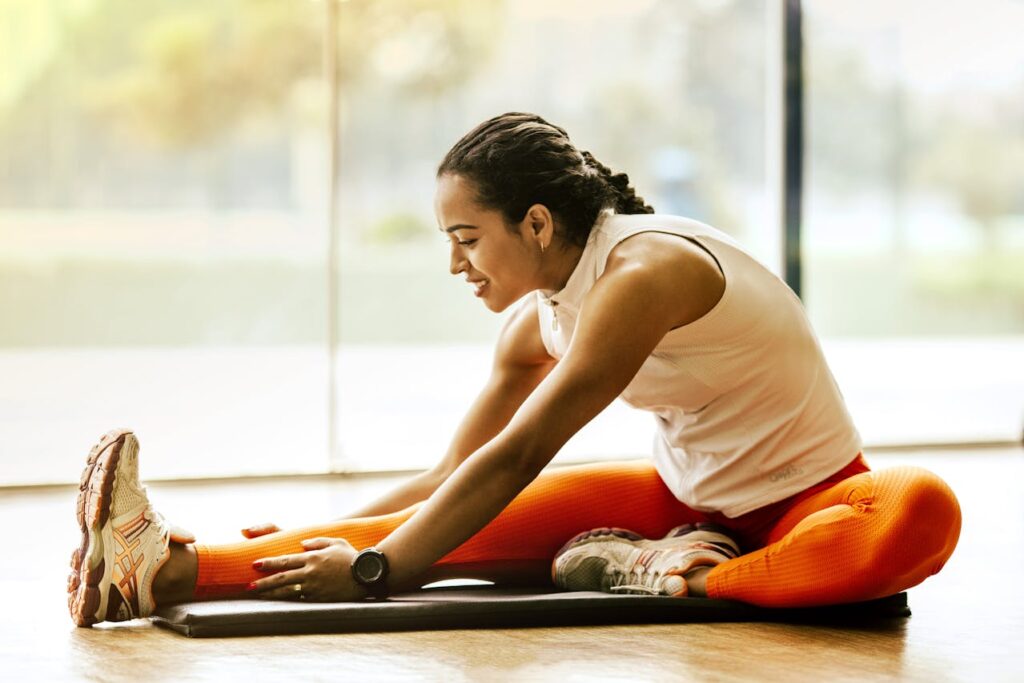Your menstrual cycle isn’t just about periods—it’s a powerful biological rhythm that affects everything from your energy levels to your strength capacity. Yet most fitness programs ignore this fundamental aspect of female physiology, treating women’s bodies as if they operate on the same 24-hour cycle as men.
What if you could work with your hormones instead of against them? What if understanding your cycle could unlock better workouts, faster recovery, and improved results?
Welcome to cycle syncing—the practice of aligning your exercise routine with your menstrual cycle phases. This isn’t about limiting what you can do; it’s about optimizing when you do it.
What Is Cycle Syncing and Why Does It Matter?
Cycle syncing involves adjusting your workout intensity, type, and focus based on the four distinct phases of your menstrual cycle. Each phase brings unique hormonal changes that affect your body’s response to exercise, recovery needs, and performance capacity.
Unlike men, who experience relatively stable hormone levels throughout the month, women navigate dramatic fluctuations in estrogen and progesterone. These hormonal shifts influence:
- Energy levels and motivation
- Strength and power output
- Recovery time and sleep quality
- Body temperature regulation
- Fuel utilization (carbs vs. fats)
- Joint stability and injury risk
The concept gained mainstream attention when the U.S. Women’s National Soccer Team began tracking players’ cycles to optimize training and performance. Professional athletes like tennis player Heather Watson have spoken openly about how menstrual cycle awareness transformed their competitive edge.
Understanding Your Menstrual Cycle: The Four Phases
Before diving into exercise recommendations, let’s break down what’s happening in your body during each phase.
Menstrual Phase (Days 1-6)
What’s happening: Your period begins as estrogen and progesterone levels drop to their lowest points. The uterine lining sheds, and your body essentially “resets” for a new cycle.
How you might feel: Fatigued, crampy, and emotionally sensitive. Energy levels are typically at their lowest, though some women experience relief once bleeding begins.
Hormonal environment: Low estrogen and progesterone create a more “male-like” hormonal profile, which can actually be advantageous for certain types of training.
Follicular Phase (Days 1-14, overlapping with menstrual)
What’s happening: Your brain signals the ovaries to prepare eggs for release. Estrogen begins its steady climb, peaking just before ovulation.
How you might feel: Energy returns and builds throughout this phase. You may feel more optimistic, social, and ready to take on challenges.
Hormonal environment: Rising estrogen improves insulin sensitivity, enhances protein synthesis, and increases pain tolerance.
Ovulatory Phase (Days 12-16)
What’s happening: A mature egg is released from the ovary. Estrogen peaks while luteinizing hormone (LH) surges to trigger ovulation.
How you might feel: This is often your energy peak. You may feel strongest, most confident, and most motivated to push your limits.
Hormonal environment: Peak estrogen levels optimize strength, power, and coordination while reducing perceived exertion.
Luteal Phase (Days 15-28)
What’s happening: After ovulation, progesterone rises significantly while estrogen fluctuates. If pregnancy doesn’t occur, both hormones crash, leading to your next period.
How you might feel: Energy may decline, especially in the final week. You might experience PMS symptoms, increased appetite, and mood changes.
Hormonal environment: High progesterone increases core body temperature, heart rate, and breathing rate while promoting muscle breakdown.
How Hormones Impact Your Exercise Performance
Understanding the science behind hormonal fluctuations helps explain why your workout might feel effortless one week and exhausting the next.
Estrogen: Your Performance Enhancer
When estrogen levels are high (follicular and ovulatory phases), your body becomes a more efficient exercise machine:
- Improved strength and power: Estrogen enhances muscle protein synthesis and reduces muscle damage
- Better coordination: Higher estrogen levels improve neuromuscular control
- Enhanced recovery: Estrogen has anti-inflammatory properties that speed healing
- Increased pain tolerance: You can push harder with less perceived effort
- Better carbohydrate utilization: Your muscles more efficiently use glucose for fuel
Progesterone: The Recovery Hormone
While often viewed as the “difficult” hormone, progesterone serves important functions:
- Promotes rest and recovery: Higher progesterone levels signal your body to prioritize restoration
- Increases core temperature: This can make high-intensity exercise feel more challenging
- Shifts fuel utilization: Your body preferentially burns fat for energy
- Affects breathing: Progesterone acts as a respiratory stimulant, increasing breathing rate
Exercise Recommendations by Cycle Phase
Now for the practical part—how to structure your workouts throughout your cycle.
Menstrual Phase Workouts (Days 1-6)
Best exercises:
- Gentle yoga or restorative yoga
- Light walking or easy cycling
- Swimming (if comfortable with tampons/cups)
- Stretching and mobility work
- Light strength training with bodyweight or minimal weights
Why this works: Low hormone levels mean reduced energy and potentially increased inflammation. Honor your body’s need for gentleness while maintaining movement to boost mood and reduce cramps.
Sample workout: 30-minute gentle flow yoga followed by 10 minutes of meditation or breathing exercises.
Follicular Phase Workouts (Days 7-14)
Best exercises:
- High-intensity interval training (HIIT)
- Heavy strength training and powerlifting
- New fitness classes or challenging workouts
- Long runs or cycling sessions
- Plyometric and explosive movements
Why this works: Rising estrogen levels enhance strength, coordination, and recovery. This is your time to push boundaries and try new challenges.
Sample workout: 45-minute strength training session focusing on compound movements (squats, deadlifts, bench press) followed by 15 minutes of HIIT.
Ovulatory Phase Workouts (Days 12-16)
Best exercises:
- Maximum effort strength training
- Competitive sports or races
- Advanced fitness classes
- High-intensity cardio
- Skills-based training requiring coordination
Why this works: Peak estrogen levels optimize performance across all metrics. If you’re going to set a personal record, this is likely when it’ll happen.
Sample workout: Competition-style training—test your one-rep max, run your fastest 5K, or tackle that advanced CrossFit workout you’ve been avoiding.
Luteal Phase Workouts (Days 15-28)
Best exercises:
- Moderate-intensity steady-state cardio
- Strength training with moderate weights and higher reps
- Pilates and barre classes
- Hiking and outdoor walks
- Yoga with some challenging poses
Why this works: Higher progesterone levels make high-intensity exercise feel harder while promoting fat burning during moderate exercise. Focus on consistency over intensity.
Sample workout: 40-minute moderate-intensity bike ride followed by 20 minutes of strength training with lighter weights and higher repetitions.
How to Track Your Menstrual Cycle for Exercise
Successful cycle syncing starts with accurate tracking. Here are the most effective methods:
Temperature Tracking
Your basal body temperature (BBT) provides the most accurate picture of your hormonal phases:
- Follicular phase: Lower temperatures (typically 97.0-97.7°F)
- Ovulation: Temperature dip followed by sustained rise
- Luteal phase: Higher temperatures (typically 97.8-98.6°F)
- Menstrual phase: Temperature drops back to baseline
Use a specialized BBT thermometer and take your temperature immediately upon waking, before getting out of bed.
Cycle Tracking Apps
Popular options include:
- Flo: Comprehensive tracking with exercise recommendations
- Clue: Science-based approach with detailed analytics
- MyFLO: Specifically designed for cycle syncing
- FitrWoman: Created for female athletes
Physical and Emotional Cues
Pay attention to:
- Energy levels throughout the day
- Sleep quality and duration
- Mood changes and motivation
- Physical symptoms (bloating, breast tenderness, cramping)
- Exercise performance and recovery
Special Considerations and Individual Variations
If You’re on Hormonal Birth Control
Synthetic hormones from birth control pills, patches, or IUDs suppress your natural cycle. You won’t experience the same hormonal fluctuations, so traditional cycle syncing may not apply. However, you can still:
- Take advantage of the placebo week when hormone levels drop
- Listen to your body’s natural energy rhythms
- Focus on periodization based on training goals rather than hormonal phases
Medical Conditions Affecting Your Cycle
Conditions like PCOS, endometriosis, or thyroid disorders can significantly impact your cycle and exercise response. Work with healthcare providers to understand how your specific condition affects your hormonal patterns and exercise capacity.
Individual Variation Is Key
Not every woman experiences dramatic cycle-related changes. Some may feel consistent energy throughout their cycle, while others notice significant fluctuations. The key is finding what works for your body.
Nutrition and Recovery Considerations
Cycle syncing extends beyond exercise to include nutrition and recovery strategies:
Follicular and Ovulatory Phases
- Higher carbohydrate intake to fuel intense workouts
- Adequate protein for muscle building and recovery
- Focus on iron-rich foods to replenish stores
Luteal and Menstrual Phases
- Increased healthy fats to support hormone production
- Magnesium-rich foods to reduce cramping and improve sleep
- Complex carbohydrates to stabilize mood and energy
Recovery Optimization
- Prioritize sleep, especially during the luteal phase
- Consider gentle massage or foam rolling during menstruation
- Adjust hydration needs based on cycle phase and exercise intensity
Common Myths and Misconceptions
Let’s address some persistent myths about exercising during your cycle:
Myth: You shouldn’t exercise during your period
Truth: Gentle exercise can actually reduce cramping and improve mood
Myth: You can’t build muscle during certain cycle phases
Truth: While optimal timing may vary, muscle building can occur throughout your cycle
Myth: Cycle syncing is just another way to limit women’s activities
Truth: When done correctly, cycle syncing empowers women to optimize their training
Getting Started: A Practical Implementation Guide
Ready to try cycle syncing? Here’s your step-by-step approach:
- Track for 2-3 cycles without changing your routine to establish your baseline patterns
- Start small by adjusting workout intensity rather than completely changing your routine
- Listen to your body over rigid rules—some days won’t match the “typical” pattern
- Be flexible and adjust based on life stress, sleep, and other factors
- Give it time—it may take several cycles to notice patterns and benefits
The Bottom Line: Work With Your Body, Not Against It
Cycle syncing isn’t about limiting what you can do—it’s about optimizing when you do it. By understanding and working with your natural hormonal rhythms, you can potentially improve your performance, reduce injury risk, and develop a more sustainable relationship with exercise.
Remember, the “best” workout is the one you can do consistently. If cycle syncing helps you maintain a regular exercise routine by honoring your body’s natural fluctuations, then it’s worth exploring.
Whether you’re a competitive athlete looking for that extra edge or someone who’s tired of fighting against their body’s natural rhythms, cycle syncing offers a science-backed approach to female-specific fitness programming.
Start tracking, start listening, and start working with your cycle instead of against it. Your body—and your performance—will thank you.
Frequently Asked Questions
Q: How long does it take to see benefits from cycle syncing?
A: Most women notice improvements in energy and workout satisfaction within 2-3 cycles of consistent tracking and adjustment. Performance benefits may take longer to become apparent.
Q: Can I still do high-intensity workouts during my period?
A: If you feel up to it, absolutely! The recommendations are guidelines, not rules. Some women actually feel energized during menstruation and perform well with intense exercise.
Q: What if my cycle is irregular?
A: Focus on tracking your symptoms and energy levels rather than strict day counts. Look for patterns in how you feel rather than calendar dates, and consider consulting a healthcare provider about cycle irregularities.
Q: Is cycle syncing backed by scientific research?
A: While research is growing, current studies show mixed results. Some research supports performance benefits during certain phases, while other studies find minimal differences. The key is individual experimentation to see what works for you.
Q: Can cycle syncing help with PMS symptoms?
A: Many women report that appropriate exercise during different cycle phases helps manage PMS symptoms, particularly mood changes and energy fluctuations. However, severe PMS should be discussed with a healthcare provider.



